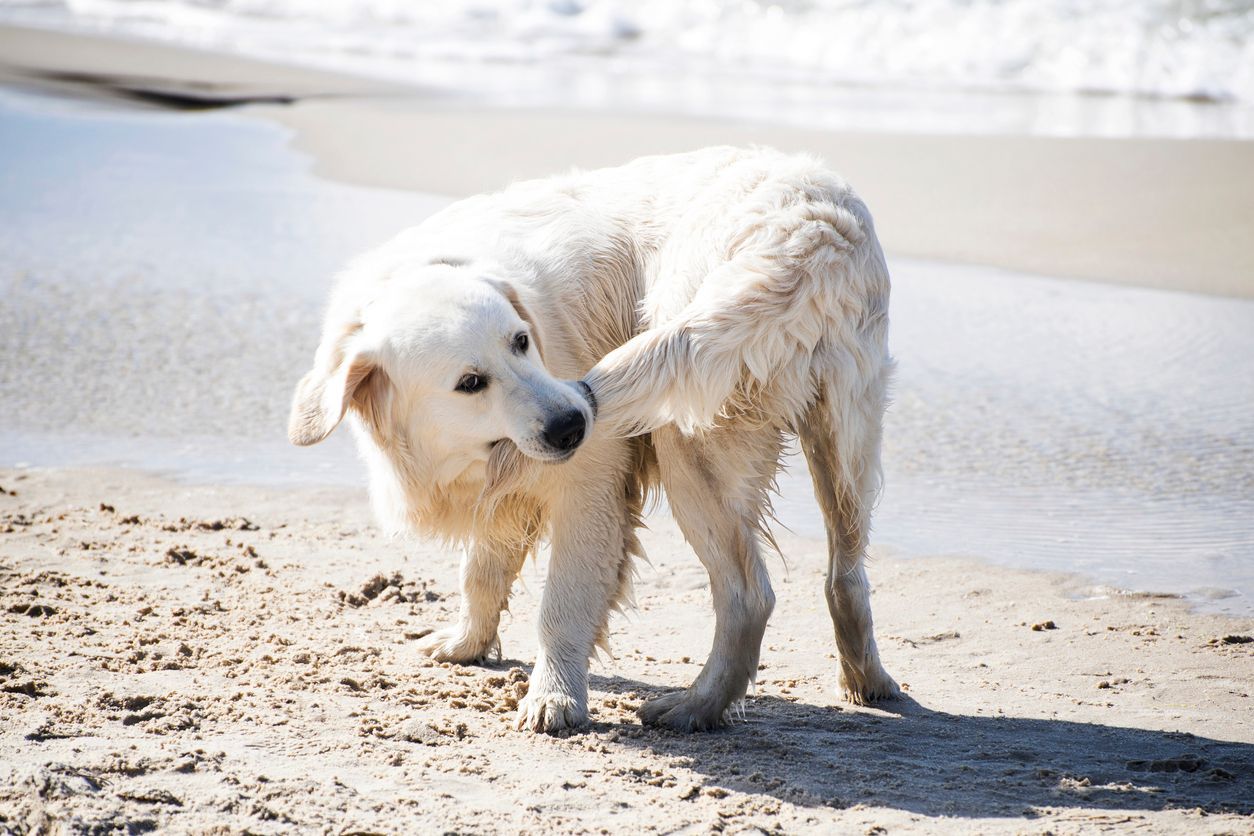How to recognize the symptoms of mastitis in dogs

Mastitis in dogs is when the breast tissue along with the mammary glands or milk ducts are inflamed. Canine mastitis is often caused by a bacterial infection in the mammary glands but may occur without infection. Symptoms of mastitis can be mild to severe. If you have a pregnant or nursing dog, read on to learn:
- What is mastitis?
- How does mastitis affect nursing puppies?
- How do I know if my dog has mastitis?
- How is mastitis in dogs diagnosed and treated?
Mastitis is most common in lactating female dogs and can risk the health of the mother and puppies. Common symptoms of mastitis in dogs include teats that are hot, firm, painful, discolored, or swollen; abnormal milk (colored or clotted); lethargy and decreased appetite in the mother; and decreased maternal interest in the puppies. Treatment for mastitis varies based on its severity and underlying cause.
What is canine mastitis?
Canine mastitis is the term for inflammation of the breast tissue and mammary glands or milk ducts. Mastitis can be caused by:
- Bacterial infection
- Trauma to the teat
- Milk stasis (backed up milk flow)
- Damp, unsanitary nursing environment
- Abrupt or forced weaning
- Fungal infection
Most cases of mastitis are due to a bacterial infection in the mammary tissue. Trauma to the teats can allow bacteria to enter, and dirty whelping areas increase the risk of bacterial infection. Milk stasis may also result in bacterial infection. Mastitis mostly affects nursing female dogs but can affect other females, such as dogs affected by false pregnancy (pseudopregnancy), and, in rare cases, male dogs.
Mastitis can be acute or chronic. Acute mastitis appears suddenly and may have severe symptoms. Chronic mastitis has a slower onset and may have few to no symptoms. If acute mastitis doesn’t receive veterinary treatment, the mammary tissue may become gangrenous with pus, abscesses, and dead tissue, which can be life-threatening for both the mother and nursing puppies.
How does mastitis affect newborn puppies?
Mothers with mastitis may allow less nursing due to discomfort in the teat, slowing weight gain in puppies. Lack of milk, poor quality milk, and the poor health of the mother can lead to fading puppy syndrome, also known as failure to thrive.
Bacterial mastitis can introduce dangerous bacteria in the milk to puppies, causing illness. Known as toxic milk syndrome, this can be fatal because puppies don’t have a complete immune system yet and can’t fight off the bacteria. Toxic milk syndrome is rare, so it’s important to get veterinary advice before preventing puppies from nursing on a teat with mastitis. In fact, encouraging puppies to nurse on affected teats is often a crucial part of treatment for mastitis in dogs.
Can mastitis affect male dogs?
Male dogs have breast tissue that can become inflamed due to trauma or infection. However, mastitis is rare in males. Swollen or inflamed breast tissue in males is far more likely to be from another medical issue.
What are the common symptoms of mastitis in dogs?
Symptoms of mastitis can vary depending on whether the condition is acute or chronic and what the underlying cause is. Signs of mastitis in dogs may include:
- Swollen, hard, or hot teats
- Puppies not gaining weight
- Decreased maternal interest in puppies
- Milk that’s discolored or of abnormal consistency
- Ulcerated skin around the mammary gland
- Dark or dead tissue on the teat or gland
- Blood or pus leaking from the teat
- Lethargy
- Fever
- Loss of appetite
- Vomiting and diarrhea
Symptoms can range from mild to severe. Puppies may or may not be affected, depending on how many teats are affected and the severity of the mastitis. It’s important to weigh puppies daily and check a nursing mother’s teats for signs of mastitis.
Is mastitis an emergency?
Mastitis needs to be promptly treated by a veterinarian to ensure puppies don’t lose weight or become malnourished. Early detection and treatment of mastitis can prevent the condition from getting worse. Gangrenous mastitis, which is when breast tissue begins to die, is a medical emergency and can lead to sepsis. Disease-causing bacteria in the milk can also lead to toxic milk syndrome in puppies, which is a rare but life-threatening condition. If you believe your puppy has toxic milk syndrome, seek diagnosis from a vet and only remove the puppy from their mother under your vet’s guidance.
Symptoms of mastitis may be similar to those of other conditions, such as mammary gland tumors. Early detection and treatment of similar conditions is very important, so it’s best to seek veterinary advice if abnormal mammary tissue is present.
How is canine mastitis diagnosed?
Veterinarians use a physical exam, patient history, and diagnostic tests to diagnose mastitis in dogs. Diagnostic testing may include:
- Blood work
- Examination of milk under a microscope
- Bacterial culture of milk
- Cytology of affected breast tissue
- Diagnostic imaging, such as X-rays or ultrasound
Identifying the underlying cause of mastitis is important, as treatment varies depending on the cause.
How is mastitis in dogs treated?
Treatment of mastitis varies based on the type of mastitis and the underlying cause. Treatment options for mastitis in dogs include:
- Warm or cold compress to the teat
- Cabbage leaf compress
- Encouraging puppies to nurse from affected teat, if approved by a veterinarian who has assessed the affected dog
- Massage or hand milking
- Antibiotic treatment
- Pain management
- Surgery (in severe cases)
Because some medications may be transferred to puppies through the milk, treatment plans may be nuanced. “Encouraging puppies to nurse from an affected teat is a crucial treatment for mastitis because it encourages milk flow and helps to unclog milk ducts. Toxic milk syndrome is rare, so it is important not to remove the puppies from the affected teat unless directed by your veterinarian,” states Dr. Jo Myers, a veterinarian on the Vetster platform. Depending on the severity of the case and the risk of toxic milk syndrome, a vet may recommend bottle-feeding for your puppies. Don’t remove puppies from the mother unless directed by a vet, as this can worsen the mastitis.
Acute mastitis or gangrenous mastitis may require aggressive treatment to ensure the survival of the mother. This may include hospitalization, surgery, and antibiotic treatments. Do not attempt to treat mastitis without a vet, as this can be dangerous to the lactating mother and puppies.
What happens if mastitis does not get veterinary attention?
Untreated mastitis, whether acute or chronic, can be life-threatening to both the mother and her puppies. Mastitis can cause a mammary gland to rupture or turn gangrenous. Ruptured or severely infected glands are extremely painful for the mother and put her at risk of sepsis. Untreated bacterial infections can spread to other teats, leading to more breast pain and the potential for a mother dog to avoid feeding her pups. Do not attempt to treat mastitis without guidance from your vet.
What should I do if I think my dog has mastitis?
Talk to a veterinarian as soon as possible if your dog shows mastitis symptoms. Mastitis in dogs can be an emergency depending on the severity and type of mastitis. Do not attempt to diagnose or treat your dog without the help of your vet. Misdiagnosis is common, and treatments can vary widely depending on the underlying cause of the mastitis. Delaying proper treatment puts both the mother and puppies at risk. If you have questions about mastitis or are unsure if your dog’s lactation is normal, an online vet is always available on Vetster to help.
FAQ - How to recognize the symptoms of mastitis in dogs
How do you know if a dog has mastitis?
Lactating female dogs are at the greatest risk of mastitis. Clinical signs of mastitis in dogs include irritated or swollen breast tissue, discoloration of milk, and puppies not gaining weight. Chronic or mild mastitis may have few to no symptoms.
What happens if nursing puppies drink mastitis milk?
Encouraging puppies to drink breast milk from an affected teat is often an essential part of treatment for mastitis. This helps remove milk clots and encourages milk to flow if it is backed up. Toxic milk syndrome can be life-threatening if the mother has a serious bacterial infection, but this condition is rare. Do not remove nursing puppies from their mother unless directed by a veterinarian.
What does early mastitis in dogs look like?
Early or chronic mastitis may show few to no symptoms. You may notice puppies aren’t gaining weight as they should or the mother is showing decreased maternal interest in her puppies. Other symptoms may include red, swollen, or hot teats; discolored milk; abnormal milk consistency; or blood leaking from the teat.




